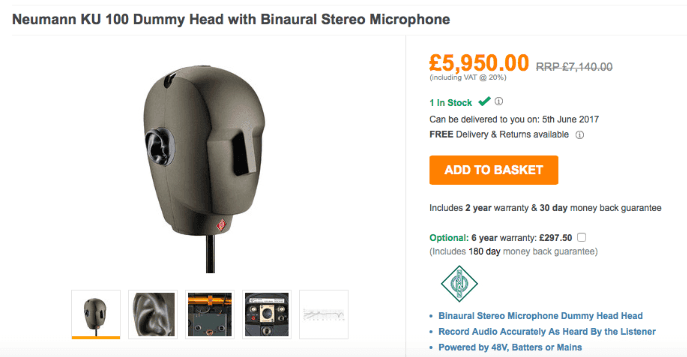Why More Independent Developers Should Use Binaural Audio In Their Games
- By Henry Scott
- •
- 02 Jun, 2017
- •
Binaural Audio Offers Dev's Multiple Ways To Create Unique Experiences With Ease!

In recent years, Independent Developers have brought us some of the most unique, engaging and diverse games we have ever seen as they are constantly pushing the bounders of what they can do with their art styles, gameplay and narrative to give us fresh and exciting experiences. A quick google search for 15 Of The Best Indie Games will give you some great titles to choose from.
Yet I find it hard to believe that there isn't a lot of indie projects that push their audio to new places. I personally feel like this is a HUGE opportunity for dev's looking for new features to separate their games from the hundreds of others on the market place. Virtual Reality has already embraced this idea, so maybe independent games should look towards 'Binaural Audio'.
Yet I find it hard to believe that there isn't a lot of indie projects that push their audio to new places. I personally feel like this is a HUGE opportunity for dev's looking for new features to separate their games from the hundreds of others on the market place. Virtual Reality has already embraced this idea, so maybe independent games should look towards 'Binaural Audio'.
What Is Binaural Audio?
If you want to learn more about what binaural audio is, there are plenty of articles online explaining what it is and how to create your own such as this post by Kall Binaural Audio. But the basic idea is that by using two very small microphones and placing them into the ear canals of a human head figurine, you can record audio that sounds as if it is coming from the specific places in the space that you're listening to it in. A Youtube video called 'Virtual Barber Shop' demonstrates the potential that this recording technique has. So why should an indie dev even consider to adopt this form of audio?
New Gameplay Machanics
With audio so clear, it can open up doors for dev's looking to create a new style or even genre of games. One such company that has embraced this is 'SomethinElse' who have developed games such as 'Papa Sangre' and 'The Night Jar' that communicate gameplay solely through audio. In 'Papa Sangre II', obstacles and objectives are represented by audio cues, meaning you must pay attention to their location as well as whether or not you should be approaching or avoiding what you can hear. I feel this idea has so much potential to be expanded on.
Whilst 'Papa Sangre' is a survival horror game, you could easily adapt this idea into a puzzle audio-based game, whereby the sound cues aren't limited to good sound/ bad sound and background sound. Sound cues could give a player clues that help them to solve problems, even revealing more or less information they need depending on the direction or the distance of the player in relation to the sound cue.
Binaural based audio cues don't necessarily need to be for audio only games either. You could easily combine this idea with a first-person game, for example it could be used for a Si-Fi or mystical themed shooter where the player must fight invisible enemies and locate them based on their sounds. 'Papa Sangre II' even had a shooter based level, so this has shown to work in the past. You guys can have those ideas for free!
Whilst 'Papa Sangre' is a survival horror game, you could easily adapt this idea into a puzzle audio-based game, whereby the sound cues aren't limited to good sound/ bad sound and background sound. Sound cues could give a player clues that help them to solve problems, even revealing more or less information they need depending on the direction or the distance of the player in relation to the sound cue.
Binaural based audio cues don't necessarily need to be for audio only games either. You could easily combine this idea with a first-person game, for example it could be used for a Si-Fi or mystical themed shooter where the player must fight invisible enemies and locate them based on their sounds. 'Papa Sangre II' even had a shooter based level, so this has shown to work in the past. You guys can have those ideas for free!
Improved Game Communication
Audio can have a big impact on a player's success in a game, whether it's a distant grenade explosion in a competitive online shooter or the sound of an enemy calling for back up in a difficult stealth game. Whilst stereo audio can deliver locational information to a certain extent, binaural audio takes this a step further by communicating to us the difference between sounds coming from in front or behind us, as well as to our left or right. A 2014 study
shows how even having the audio on can improve how we play, so combining this with more detail in the information we receive could potentially prove beneficial for players.
As well as this, immersion can be dramatically increased. Going back to our 'Papa Sangre II' example, one level finds the player trying to escape a mysterious antagonist whilst avoiding obstacles and trying to reach their goal, and the tension is sky high. Granted the game benefits from a lack of visuals, I personally feel that because you're aware of the location of the antagonist, it becomes 10x more terrifying especially when you know that there is something right behind the back of your head.
As well as this, immersion can be dramatically increased. Going back to our 'Papa Sangre II' example, one level finds the player trying to escape a mysterious antagonist whilst avoiding obstacles and trying to reach their goal, and the tension is sky high. Granted the game benefits from a lack of visuals, I personally feel that because you're aware of the location of the antagonist, it becomes 10x more terrifying especially when you know that there is something right behind the back of your head.
Accessibility
Binaural audio is more accessible than ever. Whilst some of the high end recording equipment can cost around a four figure sum...

...there are ways to accesses the equipment you need for a better price. One way to do this is by creating your own head figurine
and recording setup. DIY 3D Binaural Microphone Dummy Head for Under $100 - The Show Show - Episode 1 shows how you can build your own head and demonstrates what theirs can capture to give you an idea of the quality. They also recommend a pair of Roland CS-10EM
microphones that are designed for recording binaural audio.
Another way is to recreate binaural audio with software. For mac users, Logic Pro X comes with a built in binaural panner which allows you to essentially take any audio file you want and pan it as if it was recorded with a head figurine, as this tutorial demonstrates. I've also made my own tutorial showing how you can take this idea and the audio from it, process it in FMOD Studio and implement it into Unity 3D in a few easy steps, which you can find here.
Another way is to recreate binaural audio with software. For mac users, Logic Pro X comes with a built in binaural panner which allows you to essentially take any audio file you want and pan it as if it was recorded with a head figurine, as this tutorial demonstrates. I've also made my own tutorial showing how you can take this idea and the audio from it, process it in FMOD Studio and implement it into Unity 3D in a few easy steps, which you can find here.
The Down Sides
Whilst I strongly believe this audio would be achievable for an indie developer, I can understand why the idea might not appeal to most. Firstly, as mentioned earlier, it can be very expensive
especially if the team is small, working part time or doesn't have a dedicated audio member to manage the process. They can of corse use the two more affordable options we've addressed, but the figurines designed specifically for binaural audio would achieve the best results.
It can also be very taxing on a pc or sound card. If a developer wanted to truly create 3D binaural audio in their game, they would also have to include audio occlusion, dynamic filters, attenuation, etc, all running in real time to make it feel as believable as possible. The Past, Present, and Future of Video Game Audio! | Gnoggin is online video that, as well as explaining how audio for games has developed in the past, talks about how true binaural audio is very difficult to achieve for even AAA developers. Perhaps a hybrid of stereo and binaural audio could work as a compromise for this.
Finally, it restricts the player's audio output options. If you've checked any of the videos linked in this post, you may have noticed that they all require that you wear headphones. This is because the binaural audio relies on you listening to the audio as it was recorded, so putting distance between the output of the audio and the listener with speakers would break the affect. This isn't too much of an issue as playing games whilst wearing headphones is common, however this could be enough to put off a potential customer from purchasing the game a developer has worked so hard on.
It can also be very taxing on a pc or sound card. If a developer wanted to truly create 3D binaural audio in their game, they would also have to include audio occlusion, dynamic filters, attenuation, etc, all running in real time to make it feel as believable as possible. The Past, Present, and Future of Video Game Audio! | Gnoggin is online video that, as well as explaining how audio for games has developed in the past, talks about how true binaural audio is very difficult to achieve for even AAA developers. Perhaps a hybrid of stereo and binaural audio could work as a compromise for this.
Finally, it restricts the player's audio output options. If you've checked any of the videos linked in this post, you may have noticed that they all require that you wear headphones. This is because the binaural audio relies on you listening to the audio as it was recorded, so putting distance between the output of the audio and the listener with speakers would break the affect. This isn't too much of an issue as playing games whilst wearing headphones is common, however this could be enough to put off a potential customer from purchasing the game a developer has worked so hard on.
So to conclude, I genuinely think it is possible for a talented team to take binaural audio and create a innovative and creative experience with it. It might take some time for technology to become more powerful or a work around like a stereo/binaural hybrid as mentioned earlier might be the answer. Either way hopefully you'll be the one to take this idea and make something great!
Thanks for checking out my post, I'd love to know you thought on the subject and what you think indie dev's can do to push audio in games. If you enjoyed this feel free to check out some of my other blog posts.
Thanks for checking out my post, I'd love to know you thought on the subject and what you think indie dev's can do to push audio in games. If you enjoyed this feel free to check out some of my other blog posts.


